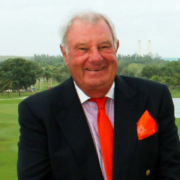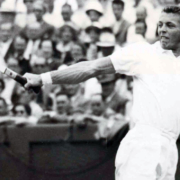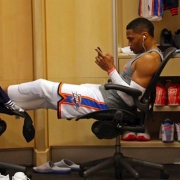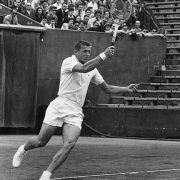Butch Buchholz Makes Ponte Vedra Home
When I first met Butch Buccholz I wasn’t surprised at what a dynamic personality he has. I’d heard his name in sports circles for years and I’d been told many stories about him by our mutual friend, tennis legend Tony Trabert. Trabert had regaled me with tales of “Butchy’s” determination as a businessman, his ability as an executive and promoter of the game, and his style and tenacity as a player.
“Butchy beat me in the finals for his first pro win,” Trabert once told me.
When I got to know Butch, he finished the story.
“Tony was running the pro tennis tour in Europe for Jack Kramer and we were short one player in the twelve-man field in Zimbabwe because Lew Hoad had broken his foot,” Buchholz recalled. So even though Tony hadn’t been playing much, he was still young enough and good enough to come in and compete. Yes, I did beat him in the finals, but he didn’t tell you we had to play the semi’s and the finals AND the doubles finals on the same Sunday because it had rained. So, we were both worn out. I went back to the hotel where all of the players stayed, and we never locked our doors or anything. I was sitting in a bath trying to keep from cramping up when “Trabes” walked in with a couple of cocktails and said, ‘Nice job Rookie.’ I don’t think that would happen in today’s game.”
Add Buchholz’s name to the growing list of sports stars and business people who have chosen to live here in North Florida. Butch and his wife Marylin moved to Ponte Vedra from South Florida a few years ago.
“I had always kept a condo in Sawgrass because we did a lot of business here with the ATP in Ponte Vedra so when we were visiting Tony and his wife Vicki, I asked Vicki’s daughter, who’s in real estate, if she could take me by my old place,” he said this week.
“We did that, and she asked if we’d ever been in The Plantation. I said, ‘No, I always turn right out of Sawgrass.’ When we went into The Plantation, we really liked it. And after knowing the prices for real estate in Boca and Miami I thought there was some mistake on the price of the house. We have friends from the ATP and the PGA Tour and access to great medical care at the Mayo Clinic. We bought it right away and just love it here.”
As a tennis player, Butch was considered a young phenom. He played his first tournament at age six and won his first tournament a year later. He won all sorts of junior amateur titles and became the first player to win junior titles at the Australian Open (1959) and French Open (1958), Wimbledon (1958) and the U.S. Junior Championships (1958). Ranked fifth in the world in 1960, Buchholz turned pro.
“In retrospect, I would have done some things differently,” Buchholz, a 2005 inductee to the International Tennis Hall of Fame explained. “We thought ‘Open’ tennis was right around the corner, the votes were very close.”
Instead, professionals were shut out of the four Grand Slam tournaments by the International Tennis Federation and most countries’ tennis associations. That spawned the beginnings of a pro circuit.
A member of three U.S. Davis Cup teams from 1958-60, Butch won 28 professional tournament events and was one of Lamar Hunt’s famous “Handsome Eight” of World Championship Tennis (WCT).
“We got the WCT trophy out of Ken Rosewall’s garage,” Buchholz said with a laugh. “It had been the trophy for our ‘Kramer Cup.’”
With the top players in the world turning pro, it was Wimbledon that help usher in the Open era of tennis and Buchholz was in the middle of it.
“Wimbledon chairman Herman David offered to have eight pros in a tournament in August of ’67 if we could sell the place out,” Butch recalled. “We did, and when it was over, he came into the locker room and said, ‘Gentlemen, you’re all invited back here next year. They’re the last people you’d think would start the revolution (of Open tennis), but they wanted the best players.”
The Open era of tennis began in 1968.
Buchholz retired as a player at the age of 29 after an injury ended his 10-year professional career. But he was just getting started.
He’s been a tournament promoter, network television commentator, and the U.S. Junior Davis Cup Team captain in 1970. He’s a founding member of the first men’s players association in 1963. He directed tournaments in his hometown of St. Louis, directed WCT events, directed a Virginia Slims event in 1972, and was Commissioner of World Team Tennis. He served as Executive Director of the ATP and started their pension program. He also started seven events in Latin America to promote the growth of the sport there.
Buchholz and his brother eventually bought and ran the tournament in South Florida, first playing in Delray Beach in 1985 and then at Boca West in ‘86. Looking for a permanent home, Butch was introduced to the Miami Parks Department who showed him a spot on Key Biscayne.
“They took me to Key Biscayne where the dump was in the park,” Buchholz recalled. “It was terrible, old cars, just awful. But I thought it was a perfect place for parking and building the tournament site.”
Building the courts and operating with temporary grandstands, they played the tournament there in 1987. Wanting to build a permanent stadium, Buccholz met stern opposition from Key Biscayne residents. After a protracted legal battle, the stadium was built in 1994.
“We started there in ’87 and helped revive the image of Miami, I believe,” he said. “We had worldwide coverage and the only other things we had were golf at Doral and the Dolphins.”
Buchholz had the idea that the Lipton International “Players Championship” should be a combined event with both men and women. No other tournaments outside of the Grand Slams did that.
“It wasn’t politically easy because a lot of tournaments wanted either men or women,” he explained. “But our success showed you could have a combined event outside of the Grand Slams. The success of Miami led to Indian Wells becoming a big, combined event. Cincinnati, Rome, and Spain followed suit. Most of the Masters series events are combined now.”
Selling the tournament to the International Management Group in 2000, Butch was contracted to stay on for five years. He was there eleven and retired.
“I’m sorry it’s gone from Key Biscayne,” he said of the Miami Open’s move to Hard Rock Stadium. “Miami was a big selling point for the players. A lot of them have friends there, the restaurants, the nightlife. Miami was a big draw.”
A member of TPC at Sawgrass through his ATP connections, Buchholz was in Ponte Vedra occasionally after retiring. But when his phone rang and it said, “PGA Tour” on the caller ID, “I thought, ‘I bet I haven’t paid my bill.’”
Instead, the Tour was interested in his promotion and Miami expertise and asked him to run their golf tournament at Doral.
“They wanted me to join the team as part of the fabric of Miami. I really enjoyed it,” he explained.
“We changed everything, you had to know Miami. They were selling hamburgers and hotdogs. We changed that to Shula Burgers and Joe’s Stone Crab. We built champagne tents. I had learned in tennis we’re in the entertainment business. It’s all about the experience. We’re putting together a wedding party for 300,000 people. We want everybody to have a good time.”
It all worked as they increased the tournament revenue by $2.1 million.
“The Trump organization did everything we asked,” Butch said of the owners of Doral. “Ivanka was our main contact. They upgraded the hotel, put on fashion shows, it really was something.”
But when Donald Trump became a candidate for President, everything changed. Members of Miami’s Latin community were offended by some of the things then-candidate Trump said regarding Mexicans and they dropped their support of the tournament. Politics got involved and the tournament disappeared to Mexico.
“The PGA Tour didn’t want to leave Miami,” Butch explained. “They’d been there fifty-six years, but they couldn’t find a sponsor.”
Buchholz generally now plays golf here in North Florida but has kept his membership at the Bear’s Club in Jupiter, mostly because of his friends there, including Jack Nicklaus. That twenty-five-year friendship is so solid he’s played golf with Nicklaus on Jack’s birthday for the last ten years.
He doesn’t play tennis any longer because of a balky elbow.
“It doesn’t bother me when I play golf,” he said with a laugh. “Just tennis.”
Although officially retired, Butch is still called on for advice about the game, and cares for it deeply.
“I’m glad I got to be a small part of changing the way the sport was presented. If I could run all of tennis for one day, I’d put everybody under one roof,”’ he said when I asked about the state of the game. “Not take any power away from anybody but get everybody on the same page.”
The move to North Florida was a conscious decision to change his lifestyle, and so far, it’s just what he and Marilyn were looking for.
“I don’t miss I-95 in Miami, that’s for sure,” he noted.
And without a hint of negative in his voice he added:
“I like the lifestyle here. A little bit of a slower pace. When we moved here, I promised my wife I’d get off a bunch of boards and I was ready to get up and not worry about what was going on. We’re enjoying it, it’s an easier lifestyle.”






